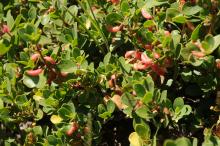Includes manzanita leafgall aphid (Tamalia coweni)
See:
Pest description and crop damage Aphids are grayish or greenish and prefer new growth. The manzanita leafgall aphid feeds on the leaves of kinnikinnick and other manzanita species (Arctostaphylos spp.). Aphids feeding causes the leaves to thicken and form bright red galls. Older galls turn brown. Severe infestations may slow the growth of the plant. Non-gall-forming aphids also may be seen occasionally on kinnikinnick. They are greenish, soft-bodied insects that may feed on leaves or stems. Honeydew, a sweet, sticky material, may be associated with aphid feeding. It may attract ants or become covered with a growth of dark, sooty mold.
Management-biological control
See:
Biological Control of Nursery Pests
Management-cultural control
Prune off and destroy galls where seen. Avoid frequent shearing and overfertilization, which encourages succulent new growth favored by aphids. For other aphid pests, wash aphids from plants with a strong stream of water or by hand-wiping. Avoid excessive watering, and use slow-release or organic sources of nitrogen. Control ants, which "farm" aphids and protect them from predators in order to harvest their honeydew.
Management-chemical control
See:
Chemical Control of Nursery Pests
Spray in spring to protect new foliage. It is important to cover foliage thoroughly, including lower leaf surfaces.
For more information
Johnson, W.T. and H.H. Lyon (1991), Insects That Feed on Trees and Shrubs, 2nd ed., Cornell University Press (p. 298).


